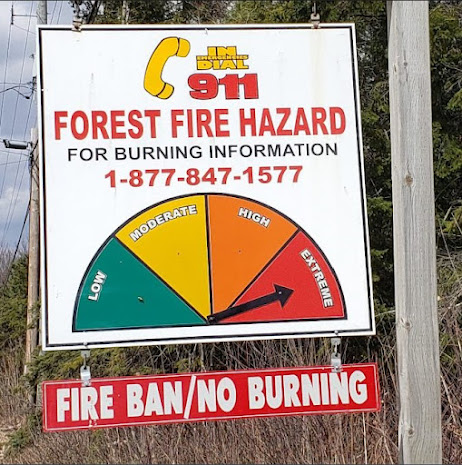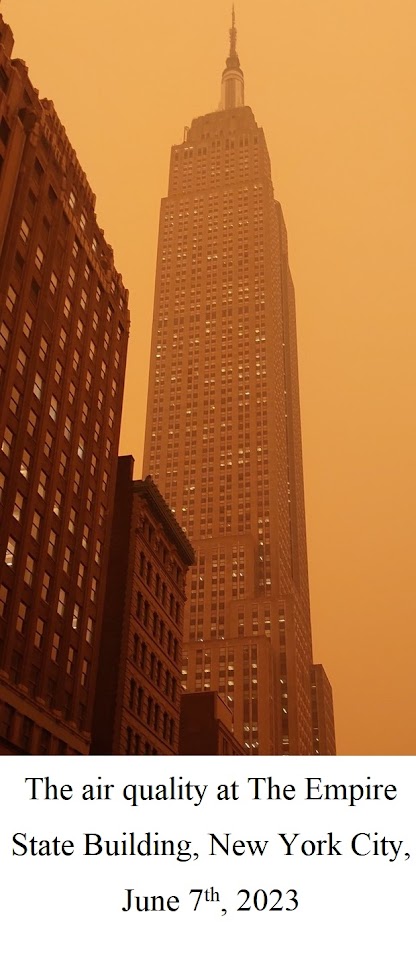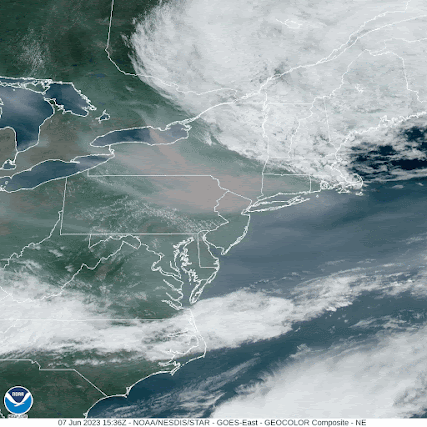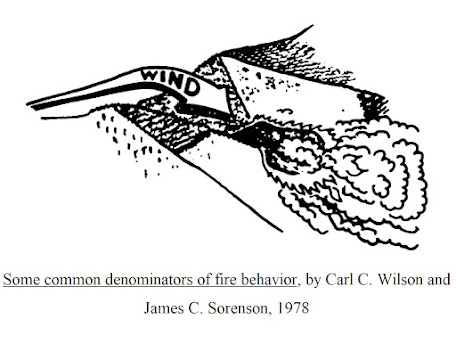But first, before
you go...
 survive a wildfire is to not be caught in one!
survive a wildfire is to not be caught in one!
So,
first, before you go pay attention to the news, check with the ranger station,
and read the weather forecasts for the area you are going to visit, to find out
if there is a fire, OR if the conditions are ripe for a blaze.
A
good source for weather conditions is the National Weather Service, HERE, and HERE, which issues red flag warnings, when the dry, unstable conditions
exist, that are ideal for a wildfire.
Thunderstorms bring lightning, which is
frequently the spark that touches off a forest fire, and winds, which fan the
flames; so be extra careful if the forecast calls for thunderstorms. And be extra careful during the afternoon
hours, when temperatures are the highest and humidity is the lowest.
If fire weather conditions exist, but there are no active fires, remember to follow all the rules and regulations regarding campfires and open burning, because you don’t want to be “THAT guy”, you know, the one who burnt up thousands of acres because he was careless!
Always
plan escape routes in case a wildfire develops near
where you are. Have at least two escape
routes, so that you can escape no matter what direction the wind is blowing,
towards or away from you.
Use
the concept of “BINGO Fuel” to help you plan your escape routes. “BINGO Fuel” is military slang for the
absolute minimum amount of fuel necessary for an aircraft to return to its
point of departure or an alternate landing strip. But, since you’re not a plane, change “fuel”
to “time”. “BINGO Time” is the absolute
minimum amount of time required for you to turn around and safely reach the
trailhead or another point of safety. It
is like the “point of no return”; that point in time where the daylight remaining
is exactly equal to your minimum “BINGO Time”.
If You Spot a Fire…Remember, it is better to be safe than sorry, so if you see signs of danger, such as smoke or flames, turn around and get out of Dodge! And when you get back to the trail head, contact 911, the county sheriff’s office, or the local rangers to report the fire.
Often
the first indication you will have that there is a fire nearby, is smoke! But it is important to remember that smoke
and ash can travel long distances, so there is no need to panic at the first
sight or scent of smoke. Wildfire smoke
can either be a general haze or a large column, boiling up from the ground!
If
you see are experiencing a general smoky haze, instead of column of smoke, then
you may OR may not be close to the source of the fire.
If
the source of the wildfire is far away, you might still be in danger because,
as everyone knows, breathing in smoke is bad for your health, and wildfire smoke
is full of nasty particles that can damage your lungs if inhaled. A light smoke or haze can leave you with a
runny nose, eye irritation and a sore throat, but a heavier smoke or haze can
cause chest pain, difficult breathing, coughing, and wheezing.
“Quebec Canada Wildfire Smoke Consumes New Jersey and New York City June 7, 2023”, by Anthony Quintano, from Wikimedia, showing “hazardous” air conditions.
So,
if you do encounter smoky or hazy air, you can determine the level of damaging
microparticles by observing the color of the sky or the thickness of the haze. If the sky is a yellowish orange to red hue, the
air is “unhealthy”, and you should leave immediately.
Another
way to determine air quality is by how far you can see. If you can see objects more than ten miles
(16 km) away the air is “good”.
If you can only see objects five miles (8 km) away, the air is “unhealthy”,
and you should consider leaving the area.
But if you can see less than one mile (less than 2 km), then the smoke levels
are “hazardous”, and you should leave the area immediately.
“Smoke column rises at the High Park Wildfire”, by the U.S. Department of Agriculture, June 22, 2012, from Wikimedia.
If you see a column of smoke, instead of a general smoky
haze, then you are close to the source of the fire. You can use the smoke
plume to make an educated guess of how far away, how big, and what direction
the fire is burning in. This will help
you assess what escape route to use and how dangerous the fire is to you. Smoke signals to look for are:
White smoke is an indicator of fire burning finer, fast burning fuels such as grass, and means that the fire is likely a fast moving, short duration fire.
Dark smoke indicates a longer lasting fire that has the potential for “spotting”. A fire that is “spotting” carried embers aloft in the smoke plume, sparking fires ahead of the main blaze.
The bigger the smoke column is, the bigger the fire is. If the column gets bigger, then the fire is growing.
If you suddenly get smoked-out, or see a nearby smoke column, it is time to head for your escape route.
“Rough Ridge Fire Smoke Columns”, National Wildfire Coordinating Group, November 11, 2016, from Wikimedia, adapted by the Author.
The direction the smoke column is bending towards is the direction the fire is moving to. Fires generally move downwind, and the smoke blows away from the fire. Fires blown by the wind can move quickly, burning at 20 mph (32 kph), or more per hour.
Remember, don’t try to outrun the fire! Instead, if the smoke is blowing 180o
away from you, escape by moving upwind, opposite to the bending plume. If the smoke column is bending towards you or
at 90o’s from your path, escape by moving perpendicular to the direction
of the wind and smoke plume.
A rising smoke column, going straight up, is a good sign, and means that there is little to no wind pushing the flames, and it will move slowly.
By checking on the conditions before you go, by having a couple of escape
plans ready to go, by observing the color and visibility of the sky and by
analyzing the smoke plume, if you come upon one, you can avoid the risks tied to
wildfires.
Don’t forget to come back next week and read the exciting conclusion
of “Surviving a Wildfire! If You Get
Caught in a Fire, Part Two ©”, where we will talk about how to survive a
wildfire, when the flames have gotten way too close!
I
hope that you continue to enjoy The Woodsman’s Journal Online and look for me
on YouTube at BandanaMan Productions for other related videos, HERE. Don’t forget to follow me on both The
Woodsman’s Journal Online, HERE,
and subscribe to BandanaMan Productions on YouTube. If you have questions, as always, feel free
to leave a comment on either site. I
announce new articles on Facebook at Eric Reynolds, on Instagram at
bandanamanaproductions, and on VK at Eric Reynolds, so watch for me.
That
is all for now, and as always, until next time, Happy Trails!
Sources
Countryman, Clive M.; Heat-Its
Role in Wildland Fire- Part 1, [U.S. Department of
Agriculture, Forest Service, Pacific Northwest, 1975], https://books.google.com/books?id=9-4TAAAAYAAJ&printsec=frontcover&dq=Fuels+for+Radiation+and+Wildland+Fire&hl=en&newbks=1&newbks_redir=0&sa=X&ved=2ahUKEwiH_eO1vsH_AhVSFVkFHXwmAuQQ6AF6BAgDEAI#v=onepage&q=Fuels%20for%20Radiation%20and%20Wildland%20Fire&f=false,
accessed June 13, 2023
Countryman, Clive M.; Radiation
and Wildland Fire, [U.S. Department of Agriculture, Forest Service, Pacific
Northwest, 1976], https://books.google.com/books?id=H2h0yRloLdwC&printsec=frontcover&dq=Fuels+for+Radiation+and+Wildland+Fire&hl=en&newbks=1&newbks_redir=0&sa=X&ved=2ahUKEwiH_eO1vsH_AhVSFVkFHXwmAuQQ6AF6BAgHEAI#v=onepage&q=Fuels%20for%20Radiation%20and%20Wildland%20Fire&f=false,
accessed June 13, 2023
Go Explore Croatia; “How
To Survive a Forest Fire”, [© 2016 Go Explore Croatia], https://goexplorecroatia.com/croatia-travel-blog-news/how-to-survive-a-forest-fire/,
accessed June 10, 2023
Green, Lisle R.; Burning
by Prescription in Chaparral, [U.S. Department of Agriculture, Forest
Service, Pacific Northwest, 1981], https://books.google.com/books?id=j2OYEfplwCEC&pg=PA31&dq=%22smoke+columns%22+wind+direction&hl=en&newbks=1&newbks_redir=0&sa=X&ved=2ahUKEwjmgJne0MH_AhUvFlkFHcG_AUc4FBDoAXoECAMQAg#v=onepage&q=%22smoke%20columns%22%20wind%20direction&f=false, accessed June 13, 2023
Kia; “How to Escape a Wildfire:
A Hikers’ Guide”, April 14, 2021, [© 2023 ATLAS & BOOTS], https://www.atlasandboots.com/travel-blog/how-to-escape-a-wildfire-a-hikers-guide/,
accessed June 10, 2023
Olivier, Jonathan; “How
to Escape a Wildfire When You’re Hiking”, June 26, 2018, [© 2023 Outside
Interactive, Inc], https://www.outsideonline.com/outdoor-adventure/hiking-and-backpacking/daily-rally-podcast-lyla-harrod/,
accessed June 10, 2023
Piven, Josh; “Survival
strategies to help you escape a forest fire”, Scouting magazine, May-June 2016,
[© 2023, Boy Scouts of America], https://scoutingmagazine.org/2016/04/survival-strategies-help-escape-forest-fire/,
accessed June 10, 2023
REI; “Wildfire Safety
Tips for Outdoor Recreation”, [© 2023 Recreational Equipment, Inc], https://www.rei.com/learn/expert-advice/wildfire-safety-tips-for-outdoor-recreation.html,
accessed June 10, 2023
Schroeder, Mark J., and
Buck, Charles C.; Fire Weather: Agricultural Handbook 360, [U.S.
Department of Agriculture, Forest Service, Broomall, PA, May 1970], https://books.google.com/books?id=j4f_lBHsSKEC&pg=PA88-IA2&dq=%22smoke+columns%22+wind+direction&hl=en&newbks=1&newbks_redir=0&sa=X&ved=2ahUKEwjI6r_dzsH_AhX4EWIAHYqwCwgQ6AF6BAgHEAI#v=onepage&q=%22smoke%20columns%22%20wind%20direction&f=false,
accessed June 13, 2023
Soares, John; “Surviving
a Wildfire While Hiking: What to Do”, July 28, 2018, [© 2023 by John Soares], https://northerncaliforniahikingtrails.com/blog/2018/07/28/surviving-wildfire-hiking-what-do/,
accessed June 10, 2023
The Trek; “How to Stay
Safe While Hiking During Wildfire Season”, [© 2023 Copyright The Trek], https://thetrek.co/how-to-stay-safe-while-hiking-during-wildfire-season/,
accessed June 10, 2023
Wikimedia; “A picture of
the empire state building”, by @Aelthemplaer on Twitter, June 7 2023, https://commons.wikimedia.org/wiki/File:Empire_State_Building_on_June_7,_2023.jpg,
accessed June 10, 2023
Wikimedia; “Quebec Canada
Wildfire Smoke Consumes New Jersey and New York City June 7 2023”, by Anthony
Quintano, https://commons.wikimedia.org/wiki/Category:Smoke_from_2023_Quebec_wildfires_in_New_York_City#/media/File:Quebec_Canada_Wildfire_Smoke_Consumes_New_Jersey_and_New_York_City_June_7_2023.jpg,
accessed June 21, 2023
Wikimedia; “Rough Ridge
Fire Smoke Columns”, National Wildfire Coordinating Group, November 11, 2016, https://commons.wikimedia.org/wiki/File:Rough_Ridge_Fire_Smoke_Columns_2016_11_11-11.45.51.039-CST.jpg,
accessed June 21, 2023
Wikimedia; “Smoke column rises at the High Park Wildfire”, by the U.S.
Department of Agriculture, June 22, 2012, https://commons.wikimedia.org/wiki/File:Smoke_column_-_High_Park_Wildfire.jpg,
accessed June 21, 2023
Wilson, Carl C., and
Sorenson, James C.; Some common denominators of fire behavior, [U.S. Department of Agriculture, Forest Service, Broomall,
PA, December 1978], https://books.google.com/books?id=w_tq7y2v8I4C&printsec=frontcover&dq=smoke+wind+direction+wildfire&hl=en&newbks=1&newbks_redir=0&sa=X&ved=2ahUKEwi78oTswcH_AhUxMVkFHSE_Dd04ChDoAXoECAkQAg#v=onepage&q&f=false, accessed June 13, 2023



































_(NYPL_b12647398-74024).tiff.jpg)













